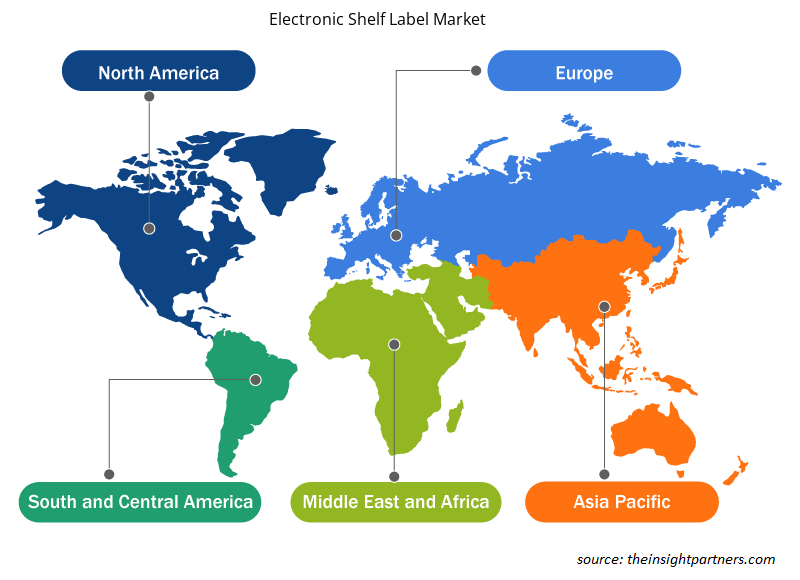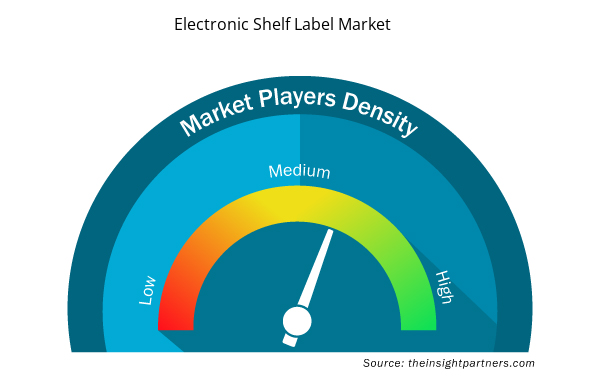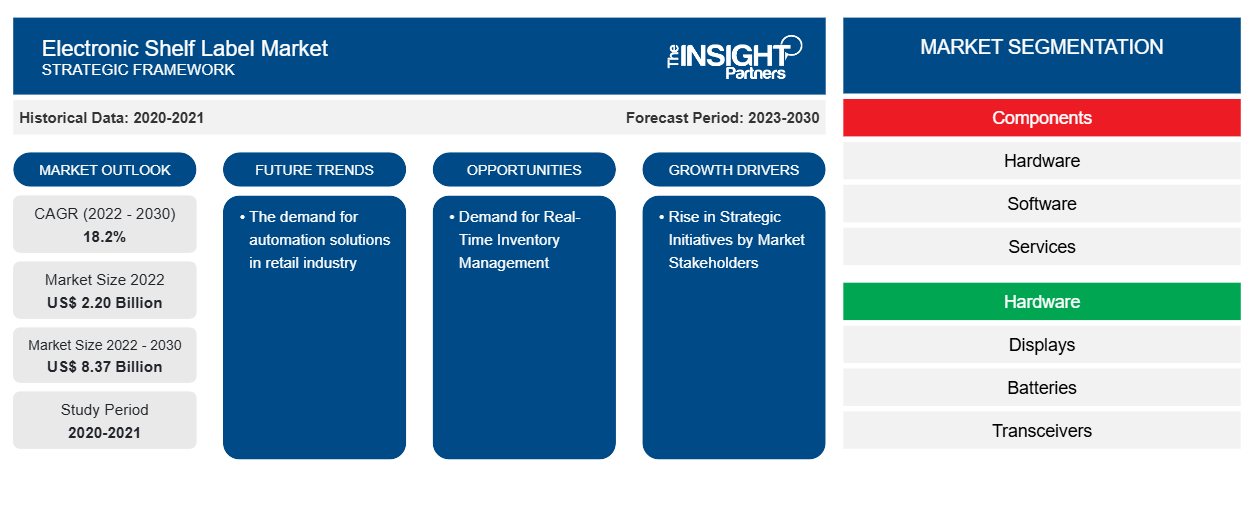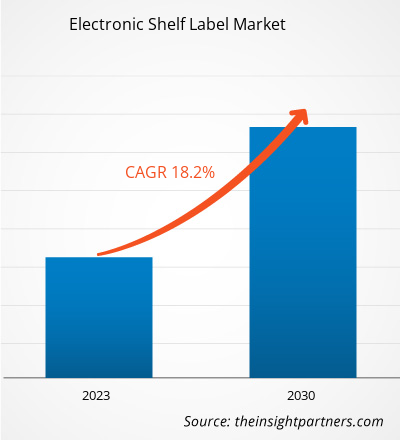Der Markt für elektronische Regaletiketten soll von 2,20 Milliarden US-Dollar im Jahr 2022 auf 8,37 Milliarden US-Dollar im Jahr 2030 anwachsen. Der Markt wird im Zeitraum 2022–2030 voraussichtlich eine durchschnittliche jährliche Wachstumsrate (CAGR) von 18,2 % verzeichnen. Die Nachfrage nach Automatisierungslösungen im Einzelhandel dürfte weiterhin ein wichtiger Trend auf dem Markt bleiben.
Marktanalyse für elektronische Regaletiketten
Faktoren wie eine steigende Anzahl von Supermärkten, Einkaufszentren und Geschäften, ein geringerer Arbeitskräftebedarf und steigende Anforderungen an die Automatisierung im Einzelhandel beeinflussen das Wachstum des Marktes für elektronische Regaletiketten . Die hohen Installationskosten und die für das System erforderliche unterstützende Infrastruktur sind jedoch die Hauptprobleme, die das Wachstum des Marktes für elektronische Regaletiketten bremsen. Darüber hinaus schreitet die Digitalisierung weltweit voran. Da das ESL-System geringe Wartungskosten verursacht, wird es im Einzelhandel aufgrund seiner Vorteile für Einzelhändler weithin angenommen. Dies schafft große Chancen für die Marktteilnehmer, die auf dem Markt für elektronische Regaletikettensysteme tätig sind. Auch die Integration von Industrie 4.0 und die Entstehung fortschrittlicher Technologien für ESL, wie ePaper mit mehrfarbigen und batterielosen Lösungen, werden den Markt für elektronische Regaletiketten voraussichtlich positiv beeinflussen.
Marktübersicht für elektronische Regaletiketten
Einzelhändler verwenden das elektronische Regaletikettensystem, um Produktpreise in Regalen anzuzeigen. Dieses System erfreut sich enormer Beliebtheit, da es Vorteile bietet, wie beispielsweise die automatische Aktualisierung der Produktpreise, wenn ein Preis von einem zentralen Kontrollserver geändert wird. Die steigende Zahl von Supermärkten, Fachgeschäften und Hypermärkten erhöht die Nachfrage nach dem Markt für elektronische Regaletiketten. Die USA, China, Frankreich, Deutschland und Japan sind die fünf führenden Länder mit dem höchsten Umsatzanteil am Markt für elektronische Regaletiketten.
Passen Sie diesen Bericht Ihren Anforderungen an
Sie erhalten kostenlos individuelle Anpassungen an jedem Bericht, einschließlich Teilen dieses Berichts oder einer Analyse auf Länderebene, eines Excel-Datenpakets sowie tolle Angebote und Rabatte für Start-ups und Universitäten.
- Holen Sie sich die wichtigsten Markttrends aus diesem Bericht.Dieses KOSTENLOSE Beispiel umfasst eine Datenanalyse von Markttrends bis hin zu Schätzungen und Prognosen.
Treiber und Chancen auf dem Markt für elektronische Regaletiketten
Zunahme strategischer Initiativen von Marktteilnehmern zur Förderung des Marktes
Die Automatisierung im Einzelhandel hat Einzelhändlern in großem Umfang Vorteile gebracht, indem sie menschliche Fehler reduziert hat. Darüber hinaus wächst der Einzelhandelssektor weltweit kontinuierlich. Nach Angaben der US-Regierung beispielsweise stiegen die Einzelhandelsumsätze in den USA um 3,1 % von 5.402,3 Milliarden US-Dollar im Jahr 2019 auf 5.570,4 Milliarden US-Dollar im Jahr 2020. Laut der India Brand Equity Foundation wird der indische Einzelhandelssektor bis 2032 voraussichtlich einen Wert von 2 Billionen US-Dollar erreichen. Der Einzelhandel legt zunehmend Wert darauf, die Gesamtbetriebskosten zu senken, indem manuelle Vorgänge in den Geschäften im Zusammenhang mit Lagerbeständen, Preisänderungen und mehr abgeschafft werden. Daher steigt die Nachfrage nach Automatisierungslösungen im gesamten Einzelhandel. Darüber hinaus umfasst das Konzept der Automatisierung auch die Nutzung von ESLS in Einzelhandelsgeschäften, um ein Maximum an manuellen Aufgaben zu eliminieren, was zur Senkung der Gemeinkosten beitragen wird.
Die Marktteilnehmer auf dem Markt für elektronische Regaletiketten (ESL) führen ESL ein, um der wachsenden Nachfrage nach Einzelhandelsprodukten gerecht zu werden. Einige der Wachstumsstrategien sind unten aufgeführt.
- Im Januar 2023 brachte Ynvisible Interactive Inc. ein großformatiges elektronisches Regaletikettendisplay für Lebensmitteleinzelhändler auf den Markt.
- Im Mai 2023 stellten Pricer & StrongPoint elektronische Regaletiketten vor, die Grafiken in Gelb, Rot, Schwarz und Weiß anzeigen können. Die Verwendung hochauflösender Grafiken und lebendiger Farben zieht mehr Kunden an und steigert den Ladenumsatz.
Daher treiben derartige strategische Initiativen der Marktteilnehmer das Wachstum des Marktes für elektronische Regaletiketten voran.
Nachfrage nach Echtzeit-Bestandsverwaltung
Der Bedarf an Lösungen zur Lagerbestandsverwaltung in Echtzeit erhöht die Nachfrage der Unternehmen nach elektronischen Regaletiketten. Herkömmliche Papieretiketten liefern Unternehmen keine genauen und zeitnahen Informationen über Lagerbestände. Dies kann zu Problemen führen, beispielsweise dass nicht vorrätige Produkte fälschlicherweise als verfügbar angezeigt werden, was wiederum die Kunden unzufrieden macht und den Umsatz des Unternehmens reduziert. Elektronische Regaletiketten können in das Lagerbestandsverwaltungssystem eines Einzelhändlers integriert werden , um Lagerbestandsaktualisierungen in Echtzeit bereitzustellen. Auf diese Weise kann das Ladenpersonal schnell und einfach erkennen, wann Produkte nachgefüllt werden müssen, und sicherstellen, dass die Kunden nicht aufgrund von Nichtverfügbarkeit enttäuscht werden.
Segmentierungsanalyse des Marktberichts für elektronische Regaletiketten
Wichtige Segmente, die zur Ableitung der Marktanalyse für elektronische Regaletiketten beigetragen haben, sind Komponente, Hardware, Produkttyp, Ladentyp und Kommunikationstechnologie.
- Basierend auf den Komponenten ist der Markt für elektronische Regaletiketten in Hardware, Software und Dienstleistungen unterteilt. Das Hardwaresegment hatte im Jahr 2022 einen größeren Marktanteil.
- Nach Hardware ist der Markt in Displays, Batterien, Transceiver, Mikroprozessoren und andere unterteilt. Das Displaysegment dürfte im Prognosezeitraum wachsen.
- In Bezug auf den Produkttyp ist der Markt für elektronische Regaletiketten in LCD-ESL und E-Paper-basierte ESL unterteilt. Das E-Paper-basierte ESL-Segment dürfte im Prognosezeitraum wachsen.
- Basierend auf der Art der Geschäfte ist der Markt in Hypermärkte, Supermärkte, Non-Food-Einzelhandelsgeschäfte, Fachgeschäfte und andere unterteilt. Das Segment der Hypermärkte dürfte im Prognosezeitraum wachsen.
- Basierend auf der Kommunikationstechnologie ist der Markt in Hochfrequenz, Infrarot, Nahfeldkommunikation und andere unterteilt. Das Hochfrequenzsegment hatte im Jahr 2022 einen größeren Marktanteil.
Marktanteilsanalyse für elektronische Regaletiketten nach geografischer Lage
Der geografische Umfang des Marktberichts für elektronische Regaletiketten ist hauptsächlich in fünf Regionen unterteilt: Nordamerika, Asien-Pazifik, Europa, Naher Osten und Afrika sowie Süd- und Mittelamerika.
Der nordamerikanische Markt für industrielle Kühlgeräte ist in die USA, Kanada und Mexiko unterteilt. Der nordamerikanische Markt für elektronische Regaletiketten wird durch die große Präsenz von Einzelhandelsgeschäften und die bedeutende Entwicklung im Einzelhandelssektor vorangetrieben. In dieser Region sind die meisten der weltweit größten Einzelhändler ansässig. Kanada und Mexiko haben ihre eigenen größten Einzelhandelsketten, und beide Länder haben Einzelhandelsunternehmen, die weltweit tätig sind. Der Einzelhandel ist für fast zwei Drittel des US-BIP verantwortlich. Zu den wichtigsten US-Einzelhandelsketten gehören Walmart, Albertsons Companies, CVS Health, Amazon, Walgreens Boots Alliance, Costco, Kroger Co. und Target.
Regionale Einblicke in den Markt für elektronische Regaletiketten
Die regionalen Trends und Faktoren, die den Markt für elektronische Regaletiketten während des gesamten Prognosezeitraums beeinflussen, wurden von den Analysten von Insight Partners ausführlich erläutert. In diesem Abschnitt werden auch die Marktsegmente und die Geografie elektronischer Regaletiketten in Nordamerika, Europa, im asiatisch-pazifischen Raum, im Nahen Osten und Afrika sowie in Süd- und Mittelamerika erörtert.

- Erhalten Sie regionale Daten zum Markt für elektronische Regaletiketten
Umfang des Marktberichts für elektronische Regaletiketten
| Berichtsattribut | Details |
|---|---|
| Marktgröße im Jahr 2022 | 2,20 Milliarden US-Dollar |
| Marktgröße bis 2030 | 8,37 Milliarden US-Dollar |
| Globale CAGR (2022 - 2030) | 18,2 % |
| Historische Daten | 2020-2021 |
| Prognosezeitraum | 2023–2030 |
| Abgedeckte Segmente | Nach Komponenten
|
| Abgedeckte Regionen und Länder | Nordamerika
|
| Marktführer und wichtige Unternehmensprofile |
|
Marktteilnehmerdichte für elektronische Regaletiketten: Auswirkungen auf die Geschäftsdynamik verstehen
Der Markt für elektronische Regaletiketten wächst rasant, angetrieben durch die steigende Nachfrage der Endnutzer aufgrund von Faktoren wie sich entwickelnden Verbraucherpräferenzen, technologischen Fortschritten und einem größeren Bewusstsein für die Vorteile des Produkts. Mit steigender Nachfrage erweitern Unternehmen ihr Angebot, entwickeln Innovationen, um die Bedürfnisse der Verbraucher zu erfüllen, und nutzen neue Trends, was das Marktwachstum weiter ankurbelt.
Die Marktteilnehmerdichte bezieht sich auf die Verteilung der Firmen oder Unternehmen, die in einem bestimmten Markt oder einer bestimmten Branche tätig sind. Sie gibt an, wie viele Wettbewerber (Marktteilnehmer) in einem bestimmten Marktraum im Verhältnis zu seiner Größe oder seinem gesamten Marktwert präsent sind.
Die wichtigsten auf dem Markt für elektronische Regaletiketten tätigen Unternehmen sind:
- EtikettenNest
- Displaydata Ltd
- Panasonic Holdings Corp
- M2C Kommunikation DOO
- Hanshow-Technologie
- Opticon Sensors Europe BV
Haftungsausschluss : Die oben aufgeführten Unternehmen sind nicht in einer bestimmten Reihenfolge aufgeführt.

- Überblick über die wichtigsten Akteure auf dem Markt für elektronische Regaletiketten
Marktnachrichten und aktuelle Entwicklungen für elektronische Regaletiketten
Der Markt für elektronische Regaletiketten wird durch die Erhebung qualitativer und quantitativer Daten nach Primär- und Sekundärforschung bewertet, die wichtige Unternehmensveröffentlichungen, Verbandsdaten und Datenbanken umfasst. Nachfolgend sind einige der Entwicklungen auf dem Markt für elektronische Regaletiketten aufgeführt:
- Hanshow hielt seine Produkteinführung „Revitalisierung und Exzellenz“ im Chongqing International Expo Center in China ab, wo das Unternehmen offiziell die vierfarbige Nebular Pro-Serie elektronischer Regaletiketten (ESLs) vorstellte. (Quelle: Hanshow, Unternehmenswebsite, April 2023)
Marktbericht zu elektronischen Regaletiketten – Umfang und Ergebnisse
Der Bericht „Marktgröße und Prognose für elektronische Regaletiketten (2020–2030)“ bietet eine detaillierte Analyse des Marktes, die die folgenden Bereiche abdeckt:
- Marktgröße und Prognose für elektronische Regaletiketten auf globaler, regionaler und Länderebene für alle wichtigen Marktsegmente, die im Rahmen des Berichts abgedeckt sind
- Markttrends für elektronische Regaletiketten sowie Marktdynamiken wie Treiber, Hemmnisse und wichtige Chancen
- Detaillierte PEST/Porters Five Forces- und SWOT-Analyse
- Marktanalyse für elektronische Regaletiketten mit Blick auf wichtige Markttrends, globale und regionale Rahmenbedingungen, wichtige Akteure, Vorschriften und aktuelle Marktentwicklungen
- Branchenlandschaft und Wettbewerbsanalyse, einschließlich Marktkonzentration, Heatmap-Analyse, prominenten Akteuren und aktuellen Entwicklungen auf dem Markt für elektronische Regaletiketten
- Detaillierte Firmenprofile
- Historische Analyse (2 Jahre), Basisjahr, Prognose (7 Jahre) mit CAGR
- PEST- und SWOT-Analyse
- Marktgröße Wert/Volumen – Global, Regional, Land
- Branche und Wettbewerbsumfeld
- Excel-Datensatz



Report Coverage
Revenue forecast, Company Analysis, Industry landscape, Growth factors, and Trends

Segment Covered
This text is related
to segments covered.

Regional Scope
North America, Europe, Asia Pacific, Middle East & Africa, South & Central America

Country Scope
This text is related
to country scope.
Häufig gestellte Fragen
The key players holding majority shares in the global electronic shelf label market are LabelNest, Displaydata Ltd, Panasonic Holdings Corp, M2C Communication DOO, Hanshow Technology, Opticon Sensors Europe BV, Ses Imagotag SA, Samsung Electro-Mechanics Co Ltd, Diebold Nixdorf, Incorporated, and Pricer AB.
The global electronic shelf label market is estimated to register a CAGR of 18.2% during the forecast period 2022–2030.
The global electronic shelf label market is expected to reach US$ 8.37 billion by 2030.
North America dominated the electronic shelf label market in 2022.
The rise in strategic initiatives by market stakeholders is the major factors that propel the global electronic shelf label market.
The demand for automation solutions in the retail industry to play a significant role in the global electronic shelf label market in the coming years.
Trends and growth analysis reports related to Electronics and Semiconductor : READ MORE..
The List of Companies - Electronic Shelf Label Market
- LabelNest
- Displaydata Ltd
- Panasonic Holdings Corp
- M2C Communication DOO
- Hanshow Technology
- Opticon Sensors Europe BV
- Ses Imagotag SA
- Samsung Electro-Mechanics Co Ltd
- Diebold Nixdorf, Incorporated
- Pricer AB
The Insight Partners performs research in 4 major stages: Data Collection & Secondary Research, Primary Research, Data Analysis and Data Triangulation & Final Review.
- Data Collection and Secondary Research:
As a market research and consulting firm operating from a decade, we have published and advised several client across the globe. First step for any study will start with an assessment of currently available data and insights from existing reports. Further, historical and current market information is collected from Investor Presentations, Annual Reports, SEC Filings, etc., and other information related to company’s performance and market positioning are gathered from Paid Databases (Factiva, Hoovers, and Reuters) and various other publications available in public domain.
Several associations trade associates, technical forums, institutes, societies and organization are accessed to gain technical as well as market related insights through their publications such as research papers, blogs and press releases related to the studies are referred to get cues about the market. Further, white papers, journals, magazines, and other news articles published in last 3 years are scrutinized and analyzed to understand the current market trends.
- Primary Research:
The primarily interview analysis comprise of data obtained from industry participants interview and answers to survey questions gathered by in-house primary team.
For primary research, interviews are conducted with industry experts/CEOs/Marketing Managers/VPs/Subject Matter Experts from both demand and supply side to get a 360-degree view of the market. The primary team conducts several interviews based on the complexity of the markets to understand the various market trends and dynamics which makes research more credible and precise.
A typical research interview fulfils the following functions:
- Provides first-hand information on the market size, market trends, growth trends, competitive landscape, and outlook
- Validates and strengthens in-house secondary research findings
- Develops the analysis team’s expertise and market understanding
Primary research involves email interactions and telephone interviews for each market, category, segment, and sub-segment across geographies. The participants who typically take part in such a process include, but are not limited to:
- Industry participants: VPs, business development managers, market intelligence managers and national sales managers
- Outside experts: Valuation experts, research analysts and key opinion leaders specializing in the electronics and semiconductor industry.
Below is the breakup of our primary respondents by company, designation, and region:

Once we receive the confirmation from primary research sources or primary respondents, we finalize the base year market estimation and forecast the data as per the macroeconomic and microeconomic factors assessed during data collection.
- Data Analysis:
Once data is validated through both secondary as well as primary respondents, we finalize the market estimations by hypothesis formulation and factor analysis at regional and country level.
- Macro-Economic Factor Analysis:
We analyse macroeconomic indicators such the gross domestic product (GDP), increase in the demand for goods and services across industries, technological advancement, regional economic growth, governmental policies, the influence of COVID-19, PEST analysis, and other aspects. This analysis aids in setting benchmarks for various nations/regions and approximating market splits. Additionally, the general trend of the aforementioned components aid in determining the market's development possibilities.
- Country Level Data:
Various factors that are especially aligned to the country are taken into account to determine the market size for a certain area and country, including the presence of vendors, such as headquarters and offices, the country's GDP, demand patterns, and industry growth. To comprehend the market dynamics for the nation, a number of growth variables, inhibitors, application areas, and current market trends are researched. The aforementioned elements aid in determining the country's overall market's growth potential.
- Company Profile:
The “Table of Contents” is formulated by listing and analyzing more than 25 - 30 companies operating in the market ecosystem across geographies. However, we profile only 10 companies as a standard practice in our syndicate reports. These 10 companies comprise leading, emerging, and regional players. Nonetheless, our analysis is not restricted to the 10 listed companies, we also analyze other companies present in the market to develop a holistic view and understand the prevailing trends. The “Company Profiles” section in the report covers key facts, business description, products & services, financial information, SWOT analysis, and key developments. The financial information presented is extracted from the annual reports and official documents of the publicly listed companies. Upon collecting the information for the sections of respective companies, we verify them via various primary sources and then compile the data in respective company profiles. The company level information helps us in deriving the base number as well as in forecasting the market size.
- Developing Base Number:
Aggregation of sales statistics (2020-2022) and macro-economic factor, and other secondary and primary research insights are utilized to arrive at base number and related market shares for 2022. The data gaps are identified in this step and relevant market data is analyzed, collected from paid primary interviews or databases. On finalizing the base year market size, forecasts are developed on the basis of macro-economic, industry and market growth factors and company level analysis.
- Data Triangulation and Final Review:
The market findings and base year market size calculations are validated from supply as well as demand side. Demand side validations are based on macro-economic factor analysis and benchmarks for respective regions and countries. In case of supply side validations, revenues of major companies are estimated (in case not available) based on industry benchmark, approximate number of employees, product portfolio, and primary interviews revenues are gathered. Further revenue from target product/service segment is assessed to avoid overshooting of market statistics. In case of heavy deviations between supply and demand side values, all thes steps are repeated to achieve synchronization.
We follow an iterative model, wherein we share our research findings with Subject Matter Experts (SME’s) and Key Opinion Leaders (KOLs) until consensus view of the market is not formulated – this model negates any drastic deviation in the opinions of experts. Only validated and universally acceptable research findings are quoted in our reports.
We have important check points that we use to validate our research findings – which we call – data triangulation, where we validate the information, we generate from secondary sources with primary interviews and then we re-validate with our internal data bases and Subject matter experts. This comprehensive model enables us to deliver high quality, reliable data in shortest possible time.


 Holen Sie sich ein kostenloses Muster für diesen Bericht
Holen Sie sich ein kostenloses Muster für diesen Bericht